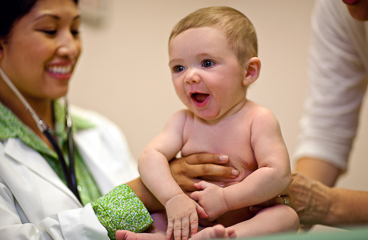Stimulating Your Baby's Development: Care Instructions

Overview
Babies change more in the first year of life than at any other time. Each baby develops at their own pace in these areas:
- Physical development is how your baby continues to grow and gain weight.
- Cognitive development is how your baby's brain starts to learn, remember, and recognize people.
- Emotional and social development starts with how your baby bonds with you and other caregivers. Most babies start to interact with others and show emotions.
- Language development is how your baby first communicates with different cries. Then your baby starts to babble. By 12 months, your baby may be able to say a few words.
- Sensory and motor development is the way your baby starts to control how they move. In the first year, babies become strong enough to sit. Some babies stand. Others take their first steps.
If your child has a delay in one area, it may not mean there is a problem. It is common for a baby to be ahead in one area and a little behind in another. But it is important to talk to your doctor if you have concerns about your baby's development. If you find problems or delays early, you'll have the best chance of treating them.
There are lots of ways you can help your baby's development. Start with simple things like loving and holding your baby. You can talk to your baby while you feed them or when you change their diapers.
Follow-up care is a key part of your child's treatment and safety. Be sure to make and go to all appointments, and call your doctor or nurse advice line (811 in most provinces and territories) if your child is having problems. It's also a good idea to know your child's test results and keep a list of the medicines your child takes.
How can you care for your child at home?
- Place your baby on his or her tummy to play while he or she is awake and you are closely watching. Play with your baby.
- Let your baby be curious and safely explore, but set limits. You may need to redirect your baby's attention. For example, if your baby tries to pull the dog's tail, show your baby a toy and move the dog to another area.
- Respond to your baby's cries. Crying is your baby's way to tell you that he or she is hungry or uncomfortable. You are not spoiling your baby by quickly responding to his or her needs.
- Make a lot of eye contact with your baby. You can do this when you feed your baby. You can also play games like peekaboo.
Help your baby learn
- Talk to your baby often. Use "baby talk." The higher pitch, slower speech, and emphasis on certain words help get your baby's attention.
- Read, smile, sing, and play music for your baby.
- Show your baby new and interesting things. Point out pictures in your home. Go for walks outside. Talk about the things you see.
- Offer your baby new words. Try words like "baby," "cat," "dog," "go," "hot," and "cold."
- Give your baby different toys to play with often. Any household object, like a spoon, can be a toy. But be careful not to give anything that could hurt your baby or that he or she could swallow.
When should you call for help?
Watch closely for changes in your child's health, and be sure to contact your doctor or nurse advice line if:
- Your child has lost a skill that he or she used to have, such as crawling.
- You have concerns about your child's vision or hearing.
- You have concerns about your baby's development.
Where can you learn more?
Go to https://www.healthwise.net/patientEd
Enter E687 in the search box to learn more about "Stimulating Your Baby's Development: Care Instructions".
Current as of: October 24, 2024
